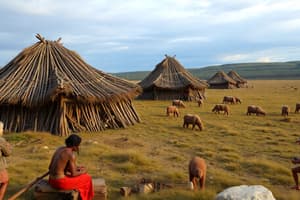Podcast
Questions and Answers
What primary factor contributed to the high death toll of Native Americans after European contact?
What primary factor contributed to the high death toll of Native Americans after European contact?
- Germs and diseases (correct)
- Overpopulation of European settlers
- Strong resistance from tribal alliances
- Lack of advanced weaponry
Why were Iroquoian tribes primarily patrilineal?
Why were Iroquoian tribes primarily patrilineal?
- Tribes had no social structure
- Gender roles were equal
- Women were dominant in agriculture
- Men controlled hunting grounds (correct)
Which of the following animals were Native Americans known to domesticate before European contact?
Which of the following animals were Native Americans known to domesticate before European contact?
- Dogs and turkeys (correct)
- Pigs and chickens
- Horses and cattle
- Sheep and goats
What was a significant consequence of Native Americans having almost no domesticated animals?
What was a significant consequence of Native Americans having almost no domesticated animals?
What was one effect of seasonal interaction through trade among Native American groups?
What was one effect of seasonal interaction through trade among Native American groups?
What was the name of the land bridge that allowed early humans to migrate from Russia to the Americas?
What was the name of the land bridge that allowed early humans to migrate from Russia to the Americas?
Which evidence suggests a genetic link between Native Americans and tribes in Siberia?
Which evidence suggests a genetic link between Native Americans and tribes in Siberia?
Which region is known for the Anasazi civilization?
Which region is known for the Anasazi civilization?
What effect did the introduction of agriculture have on Native American societies?
What effect did the introduction of agriculture have on Native American societies?
Which of the following Native American cultures primarily practiced matrilineal kinship?
Which of the following Native American cultures primarily practiced matrilineal kinship?
What characterized the relationship between agriculture and hunting among Southeastern tribes?
What characterized the relationship between agriculture and hunting among Southeastern tribes?
Which civilization is believed to have emerged in central Mexico about 300 years before European contact?
Which civilization is believed to have emerged in central Mexico about 300 years before European contact?
What was a significant challenge associated with the water/coastal migration route into the Americas?
What was a significant challenge associated with the water/coastal migration route into the Americas?
Flashcards
Beringia Land Bridge
Beringia Land Bridge
A land bridge that connected Asia and North America during the last Ice Age, allowing early humans to migrate.
Native American Migration
Native American Migration
The movement of early humans from Asia to the Americas via Beringia.
Agriculture's impact
Agriculture's impact
Led to population increase, social structure changes, and cultural developments in Native American societies.
Mesoamerican Agriculture
Mesoamerican Agriculture
Signup and view all the flashcards
Hunter-Gatherers
Hunter-Gatherers
Signup and view all the flashcards
Eastern Woodland Cultures
Eastern Woodland Cultures
Signup and view all the flashcards
Matrilineal Societies
Matrilineal Societies
Signup and view all the flashcards
Early Agricultural Centers
Early Agricultural Centers
Signup and view all the flashcards
Native American Disease Vulnerability
Native American Disease Vulnerability
Signup and view all the flashcards
European Germ Immunity
European Germ Immunity
Signup and view all the flashcards
Lack of Domesticated Animals in Americas
Lack of Domesticated Animals in Americas
Signup and view all the flashcards
Impact of European Contact on Native Americans
Impact of European Contact on Native Americans
Signup and view all the flashcards
Iroquois Societal Structure
Iroquois Societal Structure
Signup and view all the flashcards
Study Notes
Migration to the Americas
- Anthropologists and archaeologists believe migration to the Americas occurred via a land bridge called Beringia.
- This land bridge existed during the last glacial period (20,000-30,000 years ago) when sea levels were significantly lower.
- Beringia connected present-day Russia and Alaska.
- Mitochondrial DNA evidence shows a connection between Native Americans and Siberian peoples.
Evidence for Migration
- Archaeological evidence shows similar burial practices and tools on both sides of Beringia.
- Biological evidence from mitochondrial DNA shows similarities between Native Americans and Siberian groups. These similarities are not found in DNA from people in Europe, Africa, or other parts of Asia.
- Other theories, like a water route or a South Pacific route, have been proposed. However, archaeological evidence from these routes would now be underwater, and DNA evidence strongly suggests a Siberian origin.
Native American Societies & Development
- Initially, Native Americans were primarily hunter-gatherer societies.
- Agriculture developed in the central valley of Mexico around 5,000 years ago and spread outwards.
- Major agricultural areas in North America include the Anasazi (Chaco Canyon), the Adena and Hopewell (Ohio), and the Mississippian/Cahokia (Illinois) regions.
- Crop cultivation led to population growth, social hierarchies, and advancements in culture.
- Cultures like the Mayan, Toltec, and Aztec (Mexica) developed in Central Mexico.
- Many other groups combined cultivation with hunting and gathering.
- Seasonal population fluctuations (feast and famine) were common for many groups.
Contact with Europeans
- Native American populations were largely isolated before contact with Europeans.
- Trade routes existed, but contact was seasonal at best.
- After 1492, contact with Europeans led to a widespread decline in Native American populations.
- European diseases, to which they had no immunity, were the primary cause of death.
- Diseases like smallpox, influenza, and others decimated entire tribes.
- Lack of domesticated animals in the Americas meant lack of immunity to these diseases widespread amongst Europeans.
- Some tribes were completely wiped out, while others were severely weakened, making them more vulnerable to European influence.
Studying That Suits You
Use AI to generate personalized quizzes and flashcards to suit your learning preferences.




